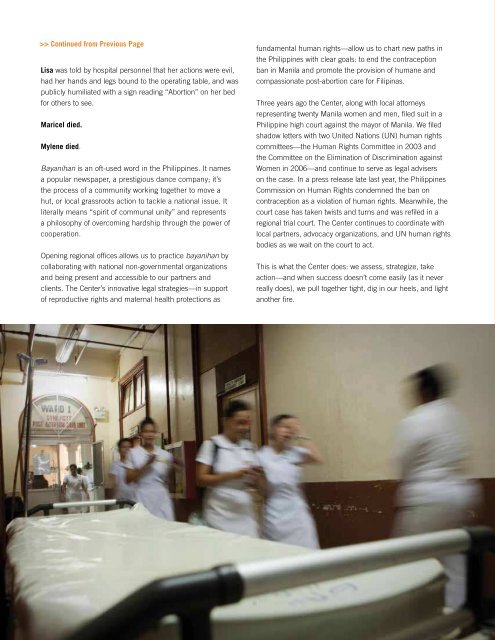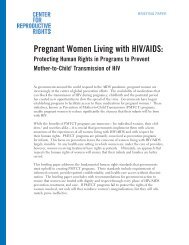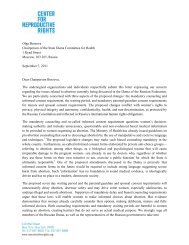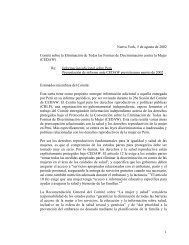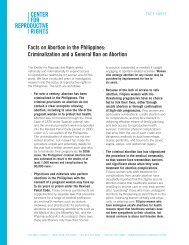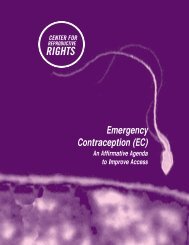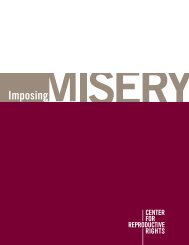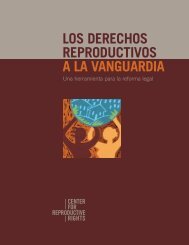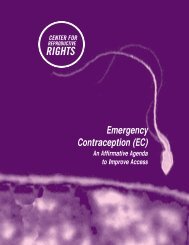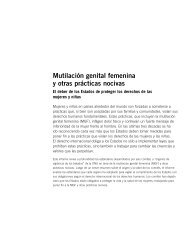Annual Report 2010-2011 - Center for Reproductive Rights
Annual Report 2010-2011 - Center for Reproductive Rights
Annual Report 2010-2011 - Center for Reproductive Rights
- No tags were found...
You also want an ePaper? Increase the reach of your titles
YUMPU automatically turns print PDFs into web optimized ePapers that Google loves.
Continued from Previous PageLisa was told by hospital personnel that her actions were evil,had her hands and legs bound to the operating table, and waspublicly humiliated with a sign reading “Abortion” on her bed<strong>for</strong> others to see.Maricel died.Mylene died.Bayanihan is an oft-used word in the Philippines. It namesa popular newspaper, a prestigious dance company; it’sthe process of a community working together to move ahut, or local grassroots action to tackle a national issue. Itliterally means “spirit of communal unity” and representsa philosophy of overcoming hardship through the power ofcooperation.Opening regional offices allows us to practice bayanihan bycollaborating with national non-governmental organizationsand being present and accessible to our partners andclients. The <strong>Center</strong>’s innovative legal strategies—in supportof reproductive rights and maternal health protections asfundamental human rights—allow us to chart new paths inthe Philippines with clear goals: to end the contraceptionban in Manila and promote the provision of humane andcompassionate post-abortion care <strong>for</strong> Filipinas.Three years ago the <strong>Center</strong>, along with local attorneysrepresenting twenty Manila women and men, filed suit in aPhilippine high court against the mayor of Manila. We filedshadow letters with two United Nations (UN) human rightscommittees—the Human <strong>Rights</strong> Committee in 2003 andthe Committee on the Elimination of Discrimination againstWomen in 2006—and continue to serve as legal adviserson the case. In a press release late last year, the PhilippinesCommission on Human <strong>Rights</strong> condemned the ban oncontraception as a violation of human rights. Meanwhile, thecourt case has taken twists and turns and was refiled in aregional trial court. The <strong>Center</strong> continues to coordinate withlocal partners, advocacy organizations, and UN human rightsbodies as we wait on the court to act.This is what the <strong>Center</strong> does: we assess, strategize, takeaction—and when success doesn’t come easily (as it neverreally does), we pull together tight, dig in our heels, and lightanother fire.Spotlight: MaternalMortality in IndiaMelissa UpretiRegional Director<strong>for</strong> AsiaMore women die due topregnancy-related causes inIndia than anywhere else in theworld. UN agencies estimatethat around 63,000 womendie each year, making upalmost one-fifth of the maternal deaths that occur annuallyworldwide. Sadly, these deaths are typically excused as anatural outcome of pregnancy, but the truth is that whentens of thousands of women die from preventable causes,their human rights to life, health, non-discrimination, andreproductive self-determination have been violated. And theirgovernment is to blame.Maternal mortality is frequently discussed in terms ofnumbers. Sometimes it’s easy to <strong>for</strong>get that we’re talkingabout individuals loved and mourned by their families. I’dbeen told as a young girl that my aunt died a few days aftergiving birth. It never occurred to me that her death was morethan just a family tragedy. None of us really questioned it:it was considered quite natural <strong>for</strong> women to die that waybecause it was so common. It was only after I had my firstchild that I revisited my acceptance and began to recognizehow people become immune to injustice; when no onequestions something wrong, it’s accepted as the norm. Thatled me to question a lot of the discrimination and injusticearound me and has shaped my work at the <strong>Center</strong>.In 2006, the <strong>Center</strong> and the Human <strong>Rights</strong> Law Network(HRLN)—a collective of human rights lawyers and socialactivists in India and the sub-continent—held the first-evertraining session on reproductive rights <strong>for</strong> lawyers in India.Our discussions centered on the strategic developmentof constitutional litigation in India to address violations ofwomen’s reproductive rights; one of the key topics was thetragic number of preventable maternal deaths.We have worked with HRLN since that time to develop anationwide litigation strategy on maternal mortality andmorbidity in India. Our goal is to secure official nationalrecognition that human rights are violated when a womandies during childbirth due to <strong>for</strong>eseeable and preventablecauses. In addition, we aim to expand and ensure women’saccess to maternal health services. These ef<strong>for</strong>ts are part ofthe <strong>Center</strong>’s global strategy to hold governments accountable<strong>for</strong> maternal deaths and create a body of norms that legallyprotect the human rights of pregnant women.HRLN has filed several public-interest cases in the last fiveyears that seek legal accountability <strong>for</strong> maternal deaths. Wehave provided technical support in many of these cases,combining a comparative and international legal perspectivewith our philosophy that reproductive rights are fundamentalhuman rights. In <strong>2010</strong> we witnessed a major victory in theDelhi High Court, demonstrating that this strategy is working.In June of that year, the Delhi High Court issued agroundbreaking decision in two maternal health and mortalitycases, recognizing the reproductive rights of pregnant womenas “inalienable survival rights.” And in November, in responseto a newspaper report about a homeless woman who gavebirth and died on the street due to lack of medical care, thesame court issued a decision in another case ordering theestablishment of shelters <strong>for</strong> destitute pregnant women. Ourfocus in the coming years is on monitoring implementationof the high court’s orders and decisions, and continuing toraise the issue’s profile at the UN, where we have alreadysuccessfully built a lot of support.A nation’s high maternal mortality rate not only involves atragic loss of life, but also represents gender discriminationand a profound disrespect <strong>for</strong> the dignity of some of the mostvulnerable members of society: poor and socially marginalizedpregnant women. We cannot expect to completely dismantlethese deeply entrenched cultural attitudes and socioeconomicdisparities within a decade’s or even a generation’s worthof progress. What we can do is use our resources to exposethe injustice that arises from these practices and holdgovernments responsible <strong>for</strong> failing to protect the rights anddignity of those who cannot defend themselves.This is our work seen in long <strong>for</strong>m, from one decade to thenext. My life’s work as an activist—and a mother of two girls—is to challenge injustice, prejudice, and discrimination <strong>for</strong> thesake of promoting the dignity of women and girls everywhere.That stance challenges and energizes me <strong>for</strong> my future yearsof work in India, in the rest of Asia, and with the <strong>Center</strong> <strong>for</strong><strong>Reproductive</strong> <strong>Rights</strong>.1617 center <strong>for</strong> reproductive rights


